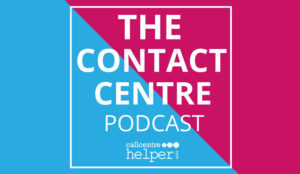Laura Bassett at NICE CXone explains how you go from reactive to proactive CX.
Your customers constantly drop breadcrumbs of data about who they are, what makes them special, and how they want you to recognize and care for them. Follow their trail and it won’t be long until you get ahead of them.
Imagine being able to communicate a problem before it hits a customer or knowing exactly how to reach out to recover a lost relationship.
Imagine giving your customers exactly what they want for exceptional CX without them having to say a thing. This is what proactive service is all about. There are no guessing games or “what ifs.” Your data does the talking, and all you need is a small amount to get started.
There’s a huge danger for companies that are not at least attempting to think about this. Eventually, you’ll have no choice. Here’s what you should know when that time comes:
- Why proactive service matters (the difference between reactive vs. proactive service)
- Business use cases for proactive service
- What proactive service goals to set
- How to start making the magic happen
Why Wait Until it’s Too Late?
Reactive service responds to an issue only after it has occurred, forcing a customer to reach out to the business (i.e., “Why is my broadband not working?”, “Why is my package delayed?”).
Proactive service flips the script by anticipating a customer’s wants, needs, and issues, empowering the business to act first to minimize customer friction and better control the outcome.
For the purposes of this blog, here’s the definition of customer friction:
Customer friction is anything that slows (or completely stops) a customer in their journey toward buying your product, having success with your product, or finding value in your product.
Most service experiences today are still reactive, like my recent experience with a toy manufacturer. I scoured the web for information to avoid calling their support centre (yes, I am that person) only to wait on hold for hours and get next to nothing as a solution. I experienced a high degree of friction in the time it took for me to resolve the issue and have success with their product.
Interestingly, the agent I spoke with told me I wasn’t the first person to bring up this issue. If I wasn’t the first, wouldn’t it have been great if the company proactively reached out to me and every other related customer with a message along the lines of, “Are you experiencing XYZ problem with this product? Click here to submit your part replacement request and enjoy 15% off your next order.”
I wouldn’t have wasted hours hunting for answers, the business would have recovered time and money, and the agent wouldn’t have squandered their time either. A proactive service approach would have improved everyone’s experience as well as KPIs and costs.
Let’s go back even further. The first thing I did to try and fix the issue was an online search. I repeatedly entered information about the manufacturer and the specific product.
Each search I completed dropped a breadcrumb of data that the company could have acted on using the right tools to reduce friction in my customer journey.
How amazing would it have been if they reached out shortly after I started my search via my preferred channel saying, “We see you’re searching for information on XYZ. Is there an issue we can help you resolve?”
This would have made my life easier, and the business would have gained better control over the experience in line with its own needs around cost, infrastructure, and KPIs. It’d be a win-win.
Proactive Service in Action: Real-Life Examples
Right Message + Right Time = Increase in Loan Application Completions
This particular financial institution had a reactive approach to unsecured applications in which agents would contact customers several days later to see if they were still interested in applying.
This follow up was too little, too late and agents were churning because they felt like they were doing menial work. The organization used NICE to run AI on its data and immediately gained actionable insights, one being the best time and day for application follow-up.
The company started contacting applicants at this time and day using their preferred channel (ex: a text that reads, “Looks like you haven’t completed your application, are you still interested? Type Y for Yes or N for No”).
If the customer says yes, they are pushed down the funnel to schedule a meeting and complete it. This proactive approach enabled the company to triple the number of successful loans written.
Better Accessibility Creates Stronger Customer Relationships
Accessibility is a huge part of proactive service. Your baseline services should make it easy for customers with impairments to switch to a suitable channel. Ideally, you would recognize what’s suitable and proactively offer it.
This is how one utility company raised the bar for CX. This business applied intelligence around its data to understand the communication preferences of its impaired customers at the individual account level and then demonstrated this knowledge by featuring each customer’s preferred channel most prominently and asking them if they’d like to set it as their default.
If yes, the customer would no longer have to hunt for their preferred channel. It would be right there waiting for them. Imagine the help they gave those customers!
One Small Change Boosts Web Conversion for a Financial Insurance Company
This particular organization couldn’t understand why customers were bouncing from its “Contact Us” web form. The form asked customers to select which services they were interested in, with liability insurance being one option.
Sure enough, the company ran AI on its data and discovered that customers were confused over what liability insurance meant. Some website visitors would drop out of what they were trying to do while others would reach out to an agent for assistance.
Driven by these data insights, the insurer added a pop-up to its form. The pop-up appears when a customer hovers over an asterisk next to “liability insurance” and provides a definition of what it is and what’s included. This significantly reduced customer friction and ensured customer success in self-service.
A Pivotal Shift to Proactive Healthcare
There are endless ways healthcare organizations can use proactive service—from converting referrals (every 1 in 8 patients in the U.S. does not use a referral) to minimizing patient leakage, which costs providers millions each year.
Appointment reminders, procedure follow-up, and between-visit support to avoid medication nonadherence are also major opportunities.
In fact, there’s a healthcare business that has defined itself around delivering proactive care. One flat monthly fee gives customers unlimited access to all its services. The more information they collect, the better they can customize care plans and anticipate health needs.
Putting the “Pro” in Proactive Service
What are the Amazons and Apples of the world doing right to deliver such great proactive service? It comes down to five things:
1. Proactively Reach Out to Customers in the Channel of Their Choice.
Reach out early on and use available knowledge to reach out in a customer’s preferred channel. This makes a huge difference for the results you want to achieve.
Consider the nonprofit industry. Did you know text messages get 12x more responses than phone calls and emails? WOW! And, only 20% of people still answer calls they don’t expect while texts are read in seconds flat.
2. When Customers Start Their Hunt for Information, Be There.
By the time a customer feels the need to reach out to you friction has already occurred. Your customers want you to be aware of when they start hunting for answers and meet them where they’re at. I recently wrote a blog on how you can start doing this.
3. Reach Out at the First Sign of Friction with Personalized, Targeted, Relevant Assistance.
Friction can’t always be avoided. If it does occur, reach out at the first sign of it with personalized, targeted, relevant assistance. Your knowledge will help you identify this friction so you know how and when to act.
4. Drive Engagement on Your Website; Don’t Hide Behind a “Contact Us” Page.
Take initiative with web visitors by offering help proactively. Don’t expect them to look for a link to chat or to search through your knowledge base or FAQs.
Be prepared to guide them to resolution on the channel they prefer if and when possible, be it chat, messaging, or SMS. The same goes for your mobile app if you have one.
5. Support Your Agents in Their Roles.
What are the top causes of friction for your agents? Do they struggle to access knowledge quickly to answer difficult questions? Do they lack guidance for how to handle interactions? Do they struggle with soft skills like empathy?
By applying AI to your data, you can push knowledge to agents that helps them better manage their soft skills, access key information like cross-channel interaction history, and handle tricky cases in real-time.
Two extra tips:
- Process is crucial. If there is no process in place for how to keep knowledge up to date, your knowledge base will either turn into a bloated collection of unstructured knowledge or a graveyard of information where content wilts. Products, knowledge, and questions continually change and mature. Your knowledge base must also mature to continue providing the high-quality content you need and customers expect.
- People don’t want to be sold, they want to be helped. Don’t use proactive service as a ploy to convert and sell. The goal is to show customers that you recognize and care for them based on an understanding of their needs, which organically pushes them down your funnel.
Making the Magic Happen
To orchestrate seamless, proactive, contextual customer experiences, you need a lot of insight into your typical customer journey.
Analytics that crunch thousands of interactions can be a huge help in finding points of friction to help you determine when to reach out and what to reach out with.
You also need to tap into all the sources of knowledge you possibly can, from your knowledge base and FAQs to online communities and social media.
There’s also the knowledge your agents and employees share. Look long and hard—there may be more than meets the eye.
This blog post has been re-published by kind permission of NICE – View the Original Article
For more information about NICE - visit the NICE Website
Call Centre Helper is not responsible for the content of these guest blog posts. The opinions expressed in this article are those of the author, and do not necessarily reflect those of Call Centre Helper.
Author: NICE
Published On: 10th Nov 2022 - Last modified: 12th Jun 2024
Read more about - Guest Blogs, Laura Bassett, NICE, NICE CXone






 NICE is a leading global enterprise software provider that enables organizations to improve customer experience and business results, ensure compliance and fight financial crime. Their mission is to help customers build and strengthen their reputation by uncovering customer insight, predicting human intent and taking the right action to improve their business.
NICE is a leading global enterprise software provider that enables organizations to improve customer experience and business results, ensure compliance and fight financial crime. Their mission is to help customers build and strengthen their reputation by uncovering customer insight, predicting human intent and taking the right action to improve their business. 











